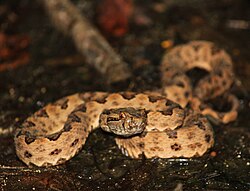Protobothrops
| Protobothrops | ||||||||||||
|---|---|---|---|---|---|---|---|---|---|---|---|---|
 Protobothrops flavoviridis | ||||||||||||
| Systematik | ||||||||||||
| ||||||||||||
| Wissenschaftlicher Name | ||||||||||||
| Protobothrops | ||||||||||||
| Hoge & Romano-Hoge, 1983 |
Protobothrops ist eine Schlangengattung aus der Familie Vipern, die in Asien verbreitet ist.
Merkmale und Lebensweise
Die oviparen Schlangen sind giftig und teilweise baumbewohnend. Einige Arten wie die Habuschlange und die Sakishima-Habu sind für den Menschen gefährlich.
Verbreitungsgebiet und Gefährdungsstatus
Die Vipern sind in Asien in China bis Indien sowie auf Japan verbreitet. Innerhalb der Gattung sind die Arten Protobothrops mangshanensis[1], die Dreihorn-Grubenotter (Protobothrops sieversorum)[2] und Protobothrops trungkhanhensis [3] als stark gefährdet („Endangered“) eingestuft. Die Art Protobothrops tokarensis[4] ist als gefährdet („Vulnerable“) und Protobothrops cornutus[5] als potentiell gefährdet („Near Threatened“) eingestuft.
Systematik
Die Gattung wurde 1983 von dem brasilianischen Herpetologen Alphonse Richard Hoge und Sylvia Romano-Hoge erstbeschrieben. Shibata et al. untersuchten 2016 die Arten der Gattung phylogenetisch. Es werden 15 Arten unterschieden, die im Folgenden nach Taxon sortiert gelistet sind (Stand Dezember 2021):[6]
| Bild | Trivialname | Taxon | Erstbeschreibung | Verbreitungsgebiet | IUCN |
|---|---|---|---|---|---|
 | Gehörnte Grubenotter | Protobothrops cornutus | (Smith, 1930) | Vietnam, China (Guangdong) | 2012 |
| Dabie-Grubenotter | Protobothrops dabieshanensis | Huang,Pan,Han,Zhang,Hou,Yu,Zheng &Zhang, 2012 | China (Anhui) | ||
 | Sakishima-Habu | Protobothrops elegans | (Gray, 1849) | Japan (Ryūkyū-Inseln) | 2018 |
 | Habuschlange | Protobothrops flavoviridis | (Hallowell, 1861) | Japan (Okinawa-Inseln, Amami-Inseln) | 2018 |
| Himalaya-Habu | Protobothrops himalayanus | Pan,Chettri,Yang,Jiang,Wang,Zhang &Vogel, 2013 | China (Süd-Tibet), Nepal, Bhutan, Indien (Sikkim) | 2021 | |
 | Gefleckte Berggrubenotter | Protobothrops jerdonii | (Günther, 1875) | (c) rbrausse, CC BY-SA 3.0 Indien (Assam, Arunachal Pradesh und weitere Regionen), Nepal, Bhutan, Nord-Myanmar, Nord-Vietnam, Südwest-China (östlich von Guangxi und Hubei, nördlich von Henan und westlich von Gansu; Yunnan, Sichuan), Höhe 1200 bis 1470 m | 2012 |
| Kaulbacks Grubenotter | Protobothrops kaulbacki | (Smith, 1940) | (c) rbrausse, CC BY-SA 3.0 Nord-Myanmar, China, Indien (Arunachal Pradesh, Papum Pare) | 2012 | |
| Omkoi-Grubenotter | Protobothrops kelomohy | Sumontha,Vasaruchapong,Chomngam,Suntrarachun,Pawangkhanant,Sompan,Smits,Kunya &Chanhome, 2020 | Nord-Thailand (Chiang Mai) | ||
 | Mangshan-Viper | Protobothrops mangshanensis | (Zhao, 1990) | China (Hunan) | 2012 |
| Maolan-Grubenotter | Protobothrops maolanensis | Yang,Orlov &Wang, 2011 | China (Guizhou, Guangxi) | 2012 | |
 | Protobothrops mucrosquamatus | (Cantor, 1839) | (c) rbrausse, CC BY-SA 3.0 Bangladesch, Indien (Assam, Arunachal Pradesh, Mizoram und weitere Regionen), Myanmar, Nord-Vietnam (Hòa Bình), Laos, Thailand, Süd-China (nördlich von Yunnan, Gansu, östlich von Zhejiang, Fujian, Kwangsi, Kwangtun, Sichuan, Hainan), Taiwan | 2011 | |
| Dreihorn-Grubenotter | Protobothrops sieversorum | (Ziegler,Herrmann,David,Orlov &Pauwels, 2000) | (c) rbrausse, CC BY-SA 3.0 Vietnam (Quảng Bình) | 2012 | |
| Tokara-Habu | Protobothrops tokarensis | (Nagai, 1928) | Japan (Takara-jima, Kotakara-jima) | 2018 | |
| Trung Khanh-Grubenotter | Protobothrops trungkhanhensis | Orlov,Ryabov &Nguyen, 2009 | Vietnam (Cao Bằng), China, Höhe 500 bis 700 m | 2012 | |
| Xiangchen-Grubenotter | Protobothrops xiangchengensis | (Zhao,Jiang &Huang, 1978) | (c) rbrausse, CC BY-SA 3.0 | 2012 |
Literatur
- Orlov, Nikolai L.; Sergei A. Ryabov, and Nguyen Thien Tao 2009. Two New Species of Genera Protobothrops Hoge et Romano-Hoge, 1983 and Viridovipera Malhotra et Thorpe, 2004 (Ophidia: Viperidae: Crotalinae) from Karst Region in Northeastern Vietnam. Part I. Description of a New Species of Protobothrops Genus. Russ. J. Herpetol. 16 (1): 69–82
- Pan, Hujun; Basundhara Chettri, Daode Yang, Ke Jiang, Kai Wang, Liang Zhang and Gernot Vogel 2013. A New Species of the Genus Protobothrops (Squamata: Viperidae) from Southern Tibet, China and Sikkim, India. Asian Herpetological Research 4 (2): 109–115
- Shibata, Hiroki; Takahito Chijiwa, Shosaku Hattori, Koki Terada, Motonori Ohno, Yasuyuki Fukumaki 2016. The taxonomic position and the unexpected divergence of the Habu viper, Protobothrops among Japanese subtropical islands. Molecular Phylogenetics and Evolution, PDF
- Yang, Jian-Huan; Nikolai L. Orlov & Ying-Yong Wang 2011. A new species of pitviper of the genus Protobothrops from China (Squamata: Viperidae). Zootaxa 2936: 59–68
Weblinks
- Protobothrops In: The Reptile Database
- Beobachtungen von Schlangen der Gattung Protobothrops. iNaturalist.
- Protobothrops, Verbreitungsgebiete. repfocus.dk (englisch).
- Protobothrops. IUCN (englisch).
Einzelnachweise
- ↑ Protobothrops mangshanensis in der Roten Liste gefährdeter Arten der IUCN 2012. Eingestellt von: Zhou, Z., 2012. Abgerufen am 23. April 2021.
- ↑ Protobothrops sieversorum in der Roten Liste gefährdeter Arten der IUCN 2012. Eingestellt von: Stuart, B., Nguyen, T.Q., 2012. Abgerufen am 23. April 2021.
- ↑ Protobothrops trungkhanhensis in der Roten Liste gefährdeter Arten der IUCN 2012. Eingestellt von: Nguyen, T.Q., 2012. Abgerufen am 23. April 2021.
- ↑ Protobothrops tokarensis in der Roten Liste gefährdeter Arten der IUCN 2018. Eingestellt von: Ota, H. & Kidera, N., 2018. Abgerufen am 23. April 2021.
- ↑ Protobothrops cornutus in der Roten Liste gefährdeter Arten der IUCN 2012. Eingestellt von: Stuart, B., Grismer, L. & Nguyen, T.Q., 2012. Abgerufen am 23. April 2021.
- ↑ Protobothrops In: The Reptile Database; abgerufen am 11. Dezember 2021.
Auf dieser Seite verwendete Medien
Autor/Urheber: (of code) -xfi-, Lizenz: CC BY-SA 3.0
The Wikispecies logo created by Zephram Stark based on a concept design by Jeremykemp.
Autor/Urheber:
- derivative work: Mareklug talk
- Status_iucn3.1.svg: Pengo
Isolated rating circle from IUCN 3.1 (one of 7: EX, EW, CR, EN, VU, LC, NT). VU denotes Vulnerable. Suitable for derivative use as individual graphics.
(c) rbrausse, CC BY-SA 3.0
geographic distribution of Protobothrops xiangchengensis (Native: China (Sichuan, Yunnan))
Autor/Urheber:
- derivative work: Mareklug talk
- Status_iucn3.1.svg: Pengo
Isolated rating circle denoting DD: Data Deficient, to complement the icons from IUCN 3.1 threat level assessment scale (EX, EW, CR, EN, VU, LC, NT). Suitable for derivative use as individual graphic, interchangeably.
Autor/Urheber: Junkyardsparkle, Lizenz: CC0
Protobothrops mangshanensis also known as Mangshan pitviper at the Los Angeles Zoo.
Trimeresurus jerdonii at the San Diego Zoo, California, USA. Identified by sign as Protobothrops j.
A Habu snake sits in a reptile tank on Kadena Air Base, Japan, May 7, 2013. The Habu is a venomous snake native to Southeast Asia and is primarily found in grassy, rocky and mountainous areas within Okinawa. There are also four species of habu on Okinawa. (U.S. Air Force photo by Airman 1st Class Hailey R. Davis/Released)
Autor/Urheber:
- derivative work: Mareklug talk
- Status_iucn3.1.svg: Pengo
Isolated rating circle from IUCN 3.1 (one of 7: EX, EW, CR, EN, VU, LC, NT). EN denotes endangered. Suitable for derivative use as individual graphics.
Autor/Urheber: Evan Pickett, Lizenz: CC BY-SA 4.0
Brown Spotted Pit Viper (Trimeresurus mucrosquamatus) from Lalashan Taiwan
(c) rbrausse, CC BY-SA 3.0
geographic distribution of Protobothrops sieversorum (Native: Lao People's Democratic Republic; Viet Nam)
Autor/Urheber:
- derivative work: Mareklug talk
- Status_iucn3.1.svg: Pengo
Isolated rating circle from IUCN 3.1 (one of 7: EX, EW, CR, EN, VU, LC, NT). Suitable for derivative use as individual graphics.
Autor/Urheber:
- derivative work: Mareklug talk
- Status_iucn3.1.svg: Pengo
Isolated rating circle from IUCN 3.1 (one of 7: EX, EW, CR, EN, VU, LC, NT). Suitable for derivative use as individual graphics.
(c) rbrausse, CC BY-SA 3.0
geographic distribution of Protobothrops jerdonii (Native: Bhutan; China; India; Myanmar; Nepal; Viet Nam)
Fan-Si-Pan horned pitviper (Protobothrops cornutus, previously Trimeresurus cornutus)
(c) rbrausse, CC BY-SA 3.0
geographic distribution Protobothrops mucrosquamatus (Native: Bangladesh; China (Anhui, Fujian, Gansu, Guangdong, Guangxi, Guizhou, Hainan, Henan, Hubei, Hunan, Jiangxi, Nei Mongol, Ningxia, Shaanxi, Shanxi, Sichuan, Yunnan, Zhejiang); Hong Kong; India; Lao People's Democratic Republic; Myanmar; Taiwan, Province of China; Viet Nam)
Autor/Urheber: Koolah (talk), Lizenz: CC BY-SA 3.0
サキシマハブ(Protobothrops elegans) at Kohama Island, Okinawa.
(c) rbrausse, CC BY-SA 3.0
geographic distribution of Protobothrops kaulbacki (Native: China; Myanmar)






















